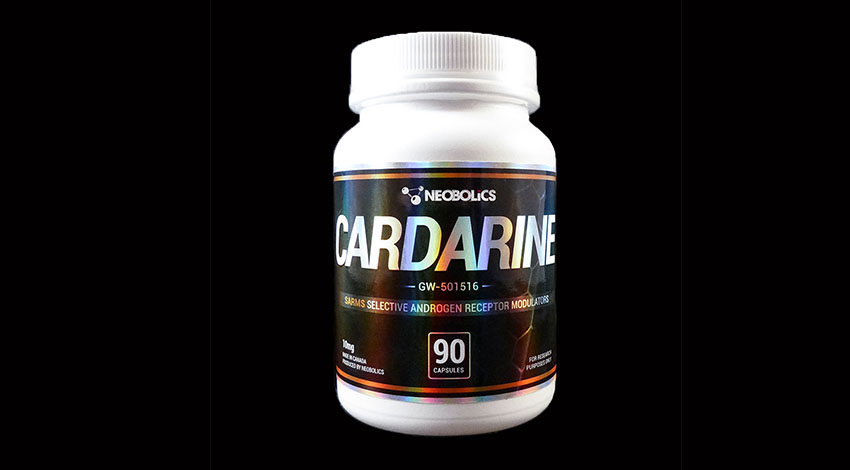While numerous individuals opt for steroids to aid in fat reduction, there are alternative medications designed for cutting purposes. One such notable compound is Cardarine. Let’s delve into a comprehensive exploration of this potent substance and its implications in the sports arena.
Unveiling Cardarine
Cardarine, scientifically referred to as GW501516, is specifically tailored to enhance endurance levels. Some might mistakenly categorize it as a SARM, although it is not.
This drug’s inception dates back to 1990, with its primary design focusing on combatting cardiovascular and metabolic disorders. Contemporary research underscores Cardarine’s capacity as a potent agonist for PPARδ, or the peroxisome proliferator-activated receptor δ.
A landmark human study spanning two years affirmed Cardarine’s benign nature, revealing that it didn’t lead to cancer and was relatively health-compliant. This revelation catalyzed its adoption by athletes, primarily to shred excess fat and bolster resilience. GW501516’s consumption promotes enhanced athletic prowess, capacitating muscles to persevere through exhaustive bouts.
Tracing Cardarine’s Sporting Legacy
As the XXIX Olympic Games of 2008 approached, speculations were rife that athletes might resort to GW501516 to amplify their stamina. The drug’s undetectable nature in conventional doping examinations and its non-prohibited status raised concerns.
To counter this potential loophole, a researcher devised a specific urine test to trace this drug, extending it to the International Olympic Committee’s purview. WADA, the vigilant entity against illicit steroids and PEDs in sports, formulated a test for GW501516 and its related PPARδ agonists, officially prohibiting them in 2009.
By 2012, WADA shifted the classification of GW501516 from a haemolysed compound to “hormone and metabolic modulators” (S4). A year later, in 2013, a global directive was issued cautioning about the potential perils associated with its use and reiterating its disapproval.
Contrary to these warnings, the rise in doping tests revealing GW501516 persisted. A case in point was the Vuelta Ciclista in Costa Rica, 2012. Four cyclists were tested positive for this substance; three faced a two-year suspension, while the fourth, with a prior offense, was handed a 12-year suspension.
Scholarly endeavors have extensively scrutinized this substance, as indicated by the following literature:
- Chen W, Gao R2, Xie X (Sci Rep. 2015 May) — A detailed metabolic exploration of GW501516.
- Russell W. Smith et al. (Biochem Biophys Rep. 2016 Dec) — Investigating its therapeutic potential.
- Péchery A et al. (Tumour Biol. 2016 Nov) — Examining its potential role in treating advanced urothelial cancers.
- Magliano DC et al. (Endocrine. 2015 Nov) — Demonstrated the drug’s efficacy in attenuating inflammatory conditions in specific lab mice.
- Mosti MP et al. (Endocrinology. 2014 Jun) — Outlined its adverse effects on bone properties in a specific rat model.
- Yangyang Ji et al. (Front Pharmacol. 2018) — Spotlighted its tumor-suppressive actions on certain carcinoma cells.
In light of these extensive research endeavors, our comprehension of Cardarine remains in flux, necessitating further scientific inquiry.
Optimal Cardarine Dosage for Athletes
Given Cardarine’s half-life of approximately 24 hours, a once-daily intake is often suggested. For athletes preferring a higher dosage, especially in the range of 20 mg or above, splitting the dosage is advisable: once every 10 to 12 hours ensures steady levels in the bloodstream. It is best consumed on an empty stomach, ideally after waking up in the morning and again in the evening prior to sleeping.
Feedback from Cardarine Consumers
At this juncture, feedback specifically targeting Cardarine’s role in sports is somewhat scarce. This scarcity can be attributed to limited availability in the sports supplement market – a consequence of production challenges, premium pricing, and the prevalence of counterfeit products. However, existing user testimonials lean toward the positive end of the spectrum.
Here are a couple of insightful reviews we’ve collated:
- “I embarked on a Cardarine cycle and am halfway through. I deliberately refrained from combining it with other drugs to better gauge its standalone impact. The result? A 3% reduction, which is commendable. Unexpectedly, I’ve also observed heightened vascularity, though it’s not a recognized benefit of Cardarine. On the vitality front, I’m faring splendidly. Even as I adhere to a restrictive, low-calorie diet, there’s no onset of fatigue or listlessness. Training sessions feel invigorating, akin to having a mild pre-workout supplement.”
- “My venture into Cardarine wasn’t motivated by weight loss aspirations, but rather a quest for enhanced energy. In the realm of CrossFit, Cardarine was exemplary. I noticed substantial improvements in certain routines, breaking through some of my plateaus. My resistance workouts, especially the high-intensity EMOMs, felt substantially more robust. Cardarine’s influence on EMOM performance is palpably positive. Overall, while Cardarine has its merits, athletes need to tread cautiously, especially where doping screenings are concerned.”
It’s crucial to note that while these testimonials offer insights into Cardarine’s potential benefits, it’s always advisable to consult a medical professional before embarking on any new supplement or medication regimen.
Cardarine: Benefits and Implications
Those who’ve experimented with Cardarine have highlighted several beneficial effects:
- Boost in Stamina: Its ban in professional sports is primarily because of the unfair advantage Cardarine provides in terms of strength, endurance, and enhanced energy production. A steady surge in stamina has been noted with typical doses ranging between 10-20 milligrams daily.
- Promotion of Weight Loss: There’s been an observed acceleration in fat burning, attributed to heightened lipolysis. Cardarine can be synergistically paired with standard fat burners for amplified weight reduction.
- Anti-Catabolic Properties: Numerous testimonials vouch for its potent anti-catabolic action. For those focusing on muscle building, a dosage of about 20mg/day is often preferred, facilitating quicker recuperation post workouts.
- Enhanced Muscle Fiber Contractility: Ideal during high-intensity workouts, Cardarine’s usage is particularly conducive for HIIT, which many experts argue is superior to traditional cardio for fat loss.
- Compatibility with SARMs: Cardarine can be paired effectively with various SARMs, resulting in an amplified anabolic impact.
The transformative effects of Cardarine, as evidenced by before-and-after results, are undoubtedly remarkable. Nonetheless, it’s crucial to remember that this substance can sometimes trigger serious and undesirable side effects.
Potential Adverse Reactions
Although sources like the Evolutionary website claim that Cardarine has a negligible side-effect profile, studies in 2007 pointed out potential carcinogenic outcomes in rat models and cell cultures. Holly E. Hollingshead’s research in the same year suggested that GW1516 didn’t spur human cancer cell proliferation. However, skepticism surrounds the conclusiveness of these findings in negating carcinogenic risks for humans.
Combining Cardarine with Other Substances
Cardarine’s surge in popularity is not solely due to its intrinsic benefits but also its synergistic compatibility with other performance-enhancing drugs. It’s widely believed that Cardarine is harmonious with numerous sports supplements, including BCAAs.
However, combining it with anabolic steroids that lead to water retention might not be ideal. In the presence of creatine supplements, Cardarine can augment workout quality while countering excessive water retention – a common creatine side effect. This results in more defined, lean muscle mass.
An example steroid cycle including Cardarine:
- Dianabol (30 mg/day)
- Cardarine (20 mg/day)
- Aromasin (or alternative aromatase inhibitors/PCT steroids)
While Cardarine emerges as a promising agent in the sports arena for optimizing fat loss and quick cutting, its long-term safety within athletic contexts remains inadequately studied. Consequently, unforeseen side effects could manifest.
Purchasing Cardarine Online
Cardarine can be found in various online sports supplement retailers, including Sarms4you, Predator Nutrition, SARMS Pharm, and Sarms1. Sadly, its sale often breaches legal boundaries. This doesn’t always imply that you’ll end up with counterfeit drugs, but illicit vendors frequently peddle inauthentic versions. It’s essential to exercise caution: thoroughly vet vendors and peruse user reviews before any online Cardarine purchase.
Disclaimer: This content does not endorse or support the use of anabolic steroids or prescription drugs in sports. Always consult a healthcare professional before making decisions related to drug or supplement intake.

